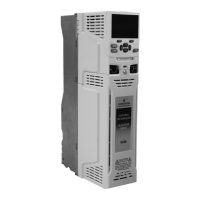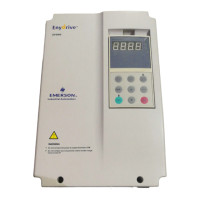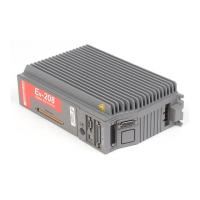Safety
information
Product
information
Mechanical
installation
Electrical
installation
Getting
started
User Menu
A
Commissioning
Advanced
Parameters
Diagnostics Optimization CT MODBUS RTU Technical Data
134 E300 Design Guide
Issue Number: 1
Table 6-5 Supported feedback types
Position Feedback Type:
Incremental Position feedback devices provide incremental feedback only and do not give absolute position feedback. The position is zero at
power-up and accumulates the change of position from that point on. These devices are suitable for motor control in RFC-A mode. In RFC-S mode, a
phasing autotune is required each time the drive is power cycled.
Incremental + Absolute Commutation Position feedback devices with commutations signals are intended to provide absolute position feedback for
motor control in RFC-S mode. The commutation signals are not used in RFC-A mode.
The commutation signals are used in RFC-S mode to determine the motor position after position feedback initialization, and after drive power up.
There must be one period of the commutation signals for each pole pair for a rotary motor (i.e. 3 commutation signal periods per revolution for a 6
pole motor). It should be noted that for a movement of up to
1
/
3
of the commutation signal period after position feedback initialization drive power up,
the maximum motor torque is limited to 0.866 of the maximum possible torque.
Absolute commutation signals only Position devices with commutations signals only are intended to provide absolute position feedback for motor
control in RFC-S mode but can also be used to provide position feedback for motor control in RFC-A mode. The position is derived from the
commutation signals alone. A phase locked loop is used to smooth the feedback, but this introduces a delay and there is significant ripple in the
position and speed feedback at low speeds. If this method is used for motor control, then low speed loop gains should be used and the speed
feedback filter should be set to its maximum value.
Incremental SINCOS An incremental SINCOS encoder can be used in the same way as an AB incremental encoder, except that the position
resolution is increased with interpolation. These devices are suitable for motor control in RFC-A mode. They can also be used for RFC-S mode, but a
phasing autotune is required each time the position feedback is initialized, the drive is power cycled.
Incremental SINCOS + Absolute comms The absolute position is obtained after position feedback initialization via the comms interface and then
after that point by tracking the incremental change from the SINCOS signals. Interpolation is used to increase the position resolution. The comms
interface can also be used for bi-directional transfer of data between the drive and encoder (except SSI comms).
These devices can be used for motor control in both RFC-A and RFC-S.
Absolute comms The absolute position is obtained at all times via the encoder comms. The comms interface can also be used for bi-directional
transfer of data between the drive and the encoder (except SSI mode). These devices can be used for motor control in RFC-A or RFC-S mode.
SINCOS + absolute single SINCOS This type of device (which is not recommended for new applications), is intended to provide absolute position
feedback for motor control in RFC-S mode. If one of these devices is used for RFC-A mode the additional sine wave signals and the Z1 marker signal
do not affect the motor control position feedback.
Communications:
Hiperface Hiperface is an asynchronous bi-directional comms protocol that is only used with incremental sine waves. It can be used to check the
position derived from the sine waves or for bi-direction data transfer between the drive and encoder. A checksum is provided for error checking.
EnDat 2.1 EnDat 2.1 is a synchronous bi-directional comms protocol that is intended to be used with incremental sine waves. It can be used to check
the position derived from the sine waves or for bi-directional data transfer between the drive and encoder. It can also be used as an absolute comms
only type position feedback interface, but the resolution of the position feedback may be limited. If it is used in this way, it is not possible to use the
position feedback via comms at the same time as communication with the encoder for data transfer. A CRC is provided for error checking.
EnDat 2.2 and BiSS C Mode EnDat 2.2 and BiSS are synchronous bi-directional comms protocols that are intended to be used alone. It is possible
to obtain position feedback at the same time as communicating with the encoder for data transfer. A CRC is provided for error checking.
SSI SSI is a uni-directional comms protocol which is intended to be used alone. The encoder provides position information only, with no possibility of
data transfer between the drive and encoder. No error checking is provided by the SSI protocol.
Encoder type Signals Position feedback type Communications
0: AB Quadrature Incremental None
1: FD Frequency and direction Incremental None
2: FR Forward and reverse Incremental None
3: AB Servo Quadrature + commutation Incremental + Absolute commutation None
4: FD Servo Frequency and direction + commutation Incremental + Absolute commutation None
5: FR Servo Forward and reverse + commutation Incremental + Absolute commutation None
6: SC SINCOS Incremental SINCOS None
7: SC Hiperface SINCOS + Hiperface comms SINCOS incremental + Absolute comms Hiperface
8: EnDat EnDat comms Absolute comms EnDat 2.1, EnDat 2.2
9: SC E
n
Dat SINCOS + EnDat comms SINCOS incremental + Absolute comm EnDat 2.1
10: SSI SSI comms Absolute comms SSI
11: SC SSI SINCOS + SSI comms SINCOS incremental + Absolute comm SSI
12: SC Servo SINCOS + commutation Incremental + Absolute commutation None
13: BiSS BiSS comms Absolute comms BiSS
15: SC SC SINCOS + single SINCOS per rev SINCOS + absolute single SINCOS None
16: Commutation Commutation only Absolute commutation only None

